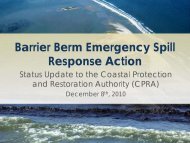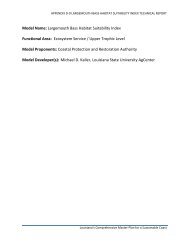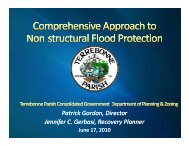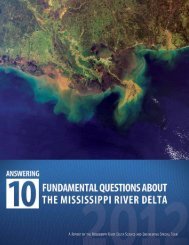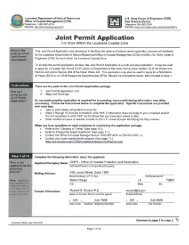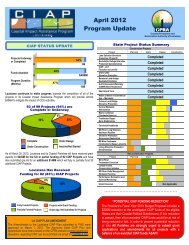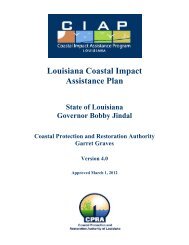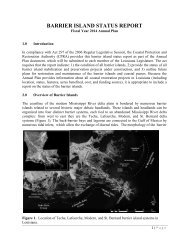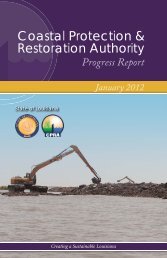State of Louisiana Initial Oil Spill Response Plan - Coastal ...
State of Louisiana Initial Oil Spill Response Plan - Coastal ...
State of Louisiana Initial Oil Spill Response Plan - Coastal ...
Create successful ePaper yourself
Turn your PDF publications into a flip-book with our unique Google optimized e-Paper software.
In an effort to assist the removal <strong>of</strong> oil from our coastal waters, minimize the interface <strong>of</strong> oil and<br />
<strong>Louisiana</strong>’s fragile coastal wetlands, marine wildlife and the communities and economies<br />
embedded therein, the <strong>State</strong> <strong>of</strong> <strong>Louisiana</strong> provides the following initial near-shore action plan<br />
and requests that it be implemented immediately. This plan was developed in coordination with<br />
affected coastal parishes. The action is feasible and cost effective when considering the potential<br />
damage that threatens our coast. The central tenet <strong>of</strong> this plan is immediate and robust action<br />
supported by the people <strong>of</strong> <strong>Louisiana</strong> who stand ready, willing, and able to assist in anyway to<br />
protect their lives and livelihoods.<br />
The state requests that all relevant training be conducted at designated sites identified herein.<br />
These training efforts should be authorized immediately and coordinated directly with coastal<br />
parishes. Training shall include: financial management under OPA90, relevant regulatory and<br />
legal guidelines, material handling, boom deployment and monitoring, oil collection protocols,<br />
and active containment strategies (containment strategies as a second line <strong>of</strong> defense) to all<br />
interested people. Training shall be <strong>of</strong>fered coast wide in Chalmette, Belle<br />
Chasse, Slidell, Houma, Golden Meadow, Morgan City, Abbeville, and Lake Charles.<br />
A concurrent action following approval <strong>of</strong> this plan is to immediately deploy booms (per the<br />
Boom Measure described below) in all <strong>of</strong> the areas identified in Appendix 1 from the mouth <strong>of</strong><br />
the Mississippi River to the <strong>Louisiana</strong>-Mississippi <strong>State</strong> line. We request that coastal parishes be<br />
authorized to lead and direct boom deployment within their respective jurisdictions. These<br />
deployment strategies may consist <strong>of</strong>: parish deployment, parish contractors (including trained<br />
fishing fleets), invoicing directly to BP, BP contractors operating under parish direction, or<br />
parishes delegating deployment to BP.<br />
Teams charged with these deployments should utilize the human resources and vessels available<br />
through trained citizens and volunteers in coordination with the <strong>Louisiana</strong> Department <strong>of</strong><br />
Wildlife and Fisheries. This workforce is available for deployment efforts, to aid in logistics,<br />
transport <strong>of</strong> materials to and from the boom deployment sites, as well as monitoring and<br />
operations <strong>of</strong> sites as appropriate.<br />
Additional plan elements including Shoreline Cleanup Assessment Team (SCAT) deployment,<br />
oil clean up, and remediation and environmental assessment, are to be implemented as directed<br />
by the Unified Command in concert with the above measures.<br />
Local knowledge, the experience and expertise <strong>of</strong> <strong>Oil</strong> <strong>Spill</strong> <strong>Response</strong> Organizations (OSRO), and<br />
the latest intelligence information on oil location and forecasts will drive the location and<br />
intensity <strong>of</strong> activity. It is assumed that the logistics and coordination will be executed by the<br />
OSRO tasked with the effort. However, the <strong>State</strong> stands ready to assist if any issues arise that<br />
may slow the pace <strong>of</strong> this much-needed and delayed response. All <strong>of</strong> this will ensure that the<br />
response is as efficient and effective as possible and allow for rapid reaction to changing<br />
conditions.<br />
2



